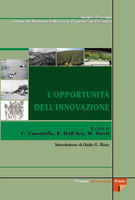L'opportunità dell'innovazione
| dc.contributor.author | Cassatella, Claudia | |
| dc.contributor.author | Dall'Ara, Enrica | |
| dc.contributor.author | Storti, Maristella | |
| dc.date.accessioned | 2010-07-15 00:00:00 | |
| dc.date.accessioned | 2020-04-01T15:29:17Z | |
| dc.date.available | 2020-04-01T15:29:17Z | |
| dc.date.issued | 2007 | |
| dc.identifier | 345115 | |
| dc.identifier | OCN: 437401545 | en_US |
| dc.identifier.uri | http://library.oapen.org/handle/20.500.12657/34903 | |
| dc.description.abstract | Over the last few years the landscape debate has taken a new turn, shifting from concerns of conservation and protection towards the search for methods of intervention and regulations that consent a development of the territory compatible with the mutation of collective requirements. This is based on a recognition of the intrinsically dynamic nature of the landscape, conceived both in its matter and in its essence as a social construct. This shift has been sanctioned by the European Landscape Convention, which includes among the objectives of landscape policy the creation of new landscapes "to satisfy the aspirations of the population involved". This book focuses on the investigation of the conditions of the context that make innovation more or less appropriate. This is assessed as a design approach (and hence no distinction will be made between design action and planning action) that addresses the "rules" dictated by what already exists. The social recognition of their value defines the "degree of freedom" of the invention. At times the rule is the very object of the project, that is the intervention is demanded precisely to conserve or valorise a landscape that is considered of exceptional value (as in the case of protected landscapes). In other cases it is a question of implementing projects with different objectives, while respecting the rules of the landscape context. Frequently the landscape does not feature a single, unequivocal and legible system of rules, but a stratification that may be incomplete, fragmentary or conflicting: the project may then attempt to knit these up, and this mechanism may trigger its added value. There are also cases in which the rule is too weak to support a revival, or is "banal", in short can be considered worth "sacrificing" to the introduction of a new system of values. Taken as a whole, the essays explore cases of landscape design, from planning to the art of the garden, identifying the appropriateness of the innovation in terms of an awareness of the rules and the intentional affirmation and expression of self. The articles contained in the book were composed specifically for the International Convention on "Innovation and Rules in Landscape Design" held in Florence on 22 and 23 November 2002, organised by the Research Doctorate in Landscape Design of the University of Florence. | |
| dc.language | Italian | |
| dc.relation.ispartofseries | Scuole di dottorato | |
| dc.subject.classification | thema EDItEUR::A The Arts::AM Architecture::AMV Landscape architecture and design | en_US |
| dc.subject.other | urbanistica | |
| dc.subject.other | town planning | |
| dc.subject.other | landscape | |
| dc.subject.other | paesaggio | |
| dc.title | L'opportunità dell'innovazione | |
| dc.type | book | |
| oapen.abstract.otherlanguage | Da non molti anni il dibattito sui temi paesistici ha imboccato una svolta, dalle preoccupazioni conservative e vincolistiche alla ricerca di metodologie d'intervento e norme attive, che consentano lo sviluppo del territorio compatibile con il mutare delle esigenze collettive . Ciò è basato sul riconoscimento della natura intrinsecamente dinamica del paesaggio, inteso nella sua materialità ma anche nel suo essere, al tempo stesso, un costrutto sociale. La svolta è sancita dalla Convenzione Europea del Paesaggio, che ammette tra gli obiettivi delle politiche del paesaggio anche la creazione di nuovi paesaggi "per soddisfare le aspirazioni della popolazione interessata". Questo volume si concentra sull'indagine delle condizioni del contesto che rendono più o meno opportuna l'innovazione. Essa è valutata in quanto atteggiamento progettuale (non si farà quindi distinzione tra azione progettuale e azione pianificatoria) nei confronti delle "regole" date dall'esistente: il riconoscimento sociale del loro valore detta il "grado di libertà" dell'invenzione. Talvolta la regola è l'oggetto stesso del progetto, ossia l'intervento è richiesto proprio per conservare/valorizzare un paesaggio considerato di eccezionale valore (è il caso, ad esempio, dei paesaggi protetti). In altri casi, si tratta di realizzare progetti con obiettivi di natura diversa, ma rispettando le regole del contesto paesistico. È frequente che il paesaggio non presenti un solo univoco e leggibile sistema di regole, ma una stratificazione talvolta incompleta, frammentaria o conflittuale: il progetto può allora tentare una ricucitura e da questo meccanismo far scaturire il suo valore aggiunto. Esistono anche casi in cui la regola è troppo debole per sostenere una ripresa, o è "banale", insomma la si giudica "sacrificabile" di fronte all' introduzione di un nuovo sistema di valori. Nel complesso i saggi raccolti esplorano occasioni di progetto di paesaggio, dalla pianificazione all'arte dei giardini, individuando l'opportunità dell'innovazione tra la consapevolezza delle regole e l'intenzionale affermazione ed espressione di sé. Gli scritti contenuti in questo volume sono stati appositamente redatti per il Convegno Internazionale "Innovazione e Regole nella Progettazione del Paesaggio", tenutosi a Firenze nelle giornate 22-23 novembre 2002, dal Dottorato di Ricerca in Progettazione Paesistica dell'Università di Firenze. | |
| oapen.identifier.doi | 10.26530/OAPEN_345115 | |
| oapen.relation.isPublishedBy | bf65d21a-78e5-4ba2-983a-dbfa90962870 | |
| oapen.relation.isbn | 9788884535641 | |
| oapen.identifier.ocn | 437401545 |

